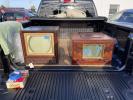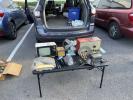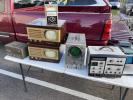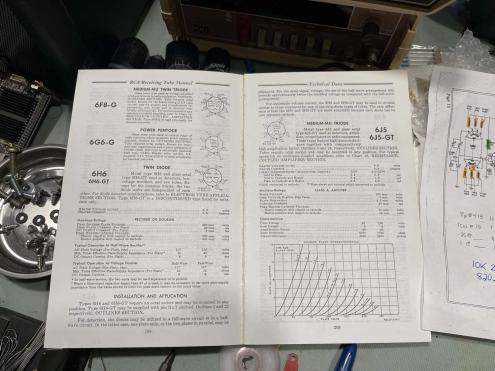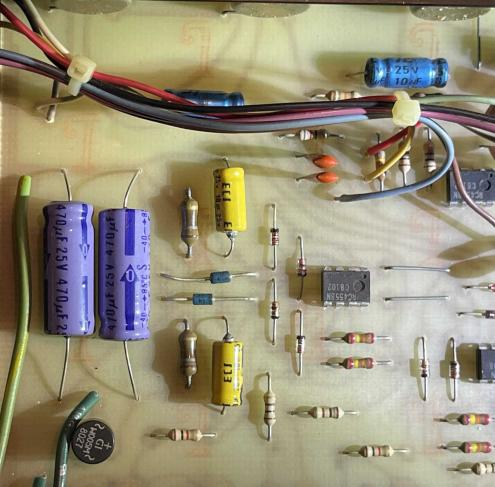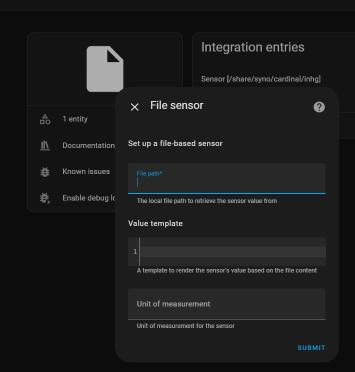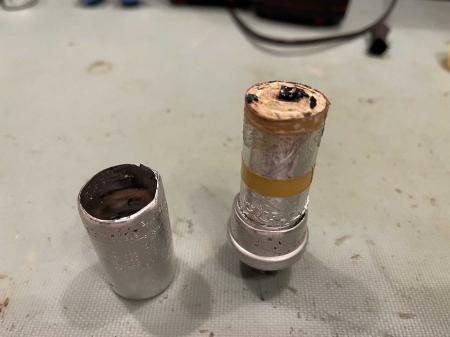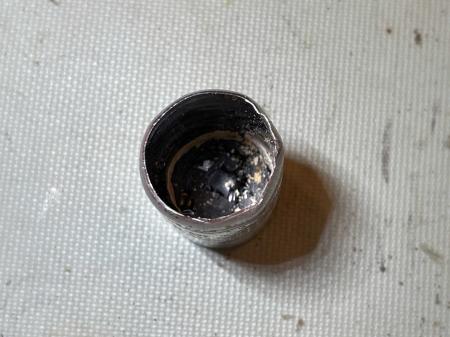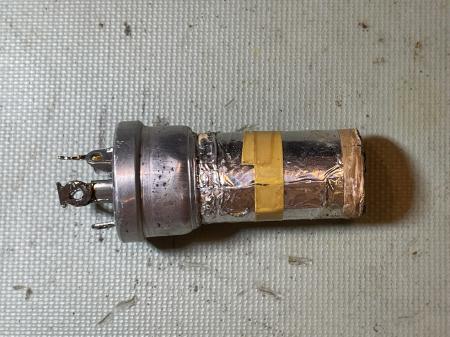- 2025
- Nov
- 24
Some last thoughts on Nostr.
I’ve been posting blog links to a federated social network called Nostr. This was mostly to drive traffic here, but I’d reply to anything that was sent to me that was not obvious spam. I’ve written about that in a couple of past posts:
Federated but disassociated: https://wereboar.com … etworking-via-nostr/
Some thoughts a few months later: https://wereboar.com … -after-a-few-months/
One of the reasons I chose the site I did was because it supported a feature of Nostr called “communities” - that’s exactly what it sounds like. A basic forum with a title and a common theme. I created /oldtech, a place for stuff like what I talk about here. While I never really got any other posts in the community, I did collect the usual spam.
Spam is a big problem on the Nostr network communities. There’s no good way to manage it, and the more popular you are the more you’ll get the standard Indian scams, crypto crap, and just general-purpose canned ham. You either approve it to show in the community, or you ignore it and it sits there in your inbox forever, waiting for you to approve it. In that regard, spam is very hard to control on Nostr, and it makes the communities messy.
Today I tried to make my usual Monday morning post and found that the site owner had removed communities in favor of a single feed of posts. The reason was that communities were “messy.” I fully understand this reasoning as there’s zero garbage control. Some of the communities I looked at had hundreds of pending spam messages in their box. (You can see pending messages, they just don’t show up in the regular feed.)
With that, my adventure with Nostr has come to and end, at least for now. I’ll check back in later in hopes it develops a little more, or perhaps I’ll find a new site that still has communities. Until then, you can find me here on wereboar, or on my mastodon feed.
Stay tuned for more hamfests, projects, and just plain junk!
- 2025
- Oct
- 19
Photos from The Early Television Museum 2025 Fall Swap Meet
This was the first time I’d gone to this show, and - while small - it offered quite a bit of television focused vendors. The usual flea market tat that shows up at hamfests these days was absent, even though the show was free to set up and enter.
I did end up spending about $45 and taking home a few project items which may show up later, depending on what I have scheduled. Regardless, here are the photos I took. I don’t have much to say about them, so there’s no description, just enjoy the glory of old television.
.
We did a museum tour as well, and that is well worth the admission price. I highly recommend that if you’re in the area. We didn’t stick around for the auction, while there were a few lunchboxes I’d like to take home I already have examples of them and do not need more.
I’ll be heading back to this one again.
- 2025
- Oct
- 9
You know the stuff you’re working on is old when…
…even your reprint manuals are starting to fall apart. My reprinted copy of the RCA RC-19 tube manual has started to break apart, the glued binding giving way.
This book probably qualifies as an antique itself!
- 2025
- Sep
- 29
Random board shot: A Biamp electronic crossover
Today’s board comes to you from a resale shop. A friend purchased this (used) electronic crossover for his audio stack, and wanted to open it up to give the controls a cleaning and give it a general once-over. Inside was a well laid-out board with plenty of space and a bunch of antique RCA op-amps. The unit works great, and immediately went into the stack.
However, seeing as this was made in the 1980s right here in the USA, we looked for that one particular mark:
Yep, there it is. That orange script “T” indicating the raw board was manufactured at the GE plant on South 2nd Street in Coshocton, Ohio.
How many stories could the board manufactured there tell us?
- 2025
- Jul
- 4
This is Project’s 4th anniversary.
July 4th, 2021 is when I opened this as pygg.xyz and transferred some of my old blogger.com content here.
I don’t have anything special to present except thank you - I appreciate all of the views I get here, and I hope you’ve found something of interest over the past 4 years.
I have a number of devices and shows in the works, please check back soon.
- 2025
- Jul
- 3
Connecting a shared drive and file sensor to Home Assistant Green.
The Home Assistant Green is just a Linux boxen running a containerized version of Home Assistant under a minimalist operating system. Technically, it should be able to do anything that the kernal supports, and one of those things is connecting to a shared drive.
I have a Raspberry Pi that has an I2C air pressure sensor connected to it. Once a minute, a cronjob reads that sensor and writes it to a location on the network - in this case a shared folder on a NFS-connected Synology drive. That file is then available for other programs to use - primarily my own garbage php frontend, and Cacti. Since Home Assistant has a nicer frontend than Cacti, I’d also like to present it there.
There’s a lot of conflicting information on how to do this online, and again - the documentation HA provides is just someone’s thought process. It’s actually fairly easy once you figure it out, however.
For this exercise, I’m using my older NFS connected Synology NAS. It has older versions of NFS opened up to the entire network. I’m not going to go into how to do that since I’m running a pre 5.0 variant, but if you want to do this for yourself make sure you understand how the NFS process works, and that you can connect to it. I’m also going to assume that you know how to access the configuration files in your system.
In order to create this new sensor, there are several steps:
1: Create the NFS share on your target device.
2: Create the share in Home Assistant
3: Allow HA to access the share
4: Create the sensor
1: We’ve already covered this, you need to make sure you can do this on your own.
2: Creating a share in Home Assistant is much easier than it used to be. Since a version in 2023, the system now has this builtin to the GUI. To access this, go to:
settings (sidebar gear icon) > system > storage > add network storage
You’ll get a window that looks like this:
Give your share a name. I’m going to call my share raspi, because it was originally set up to share files between multiple SBCs on my network. This is the name that the HA process will use when you access it, so make it meaningful, one word, and as short as you can so you don’t have to type a lot of long things. Or, do whatever you like, but I’d suggest keeping it to a single, no-space word. I don’t know how HA handles spaces here.
The next section is entitled “Useage” - this is kind of misleading, as the only thing this does is identify where the share will be located under the HA process. For example, if you choose “share,” your file path will be “/share/raspi” - it’s more of a human readable delineation than an actual “thou shalt only put thine backup here” type of thing. I chose share just because why not.
Next, choose the type of connection you want to make, NFS or CIFS. CIFS is just a fancy name for the type of shares that a Windows system uses, while NFS is the preferred Linux connection method. There’s plenty of info out there on what these acronyms mean if you’re so inclined.
CIFS usually requires a user/pass/domain type thing (Think your windows login and workgroup) whereas NFS can just operate based on IP address limiting. Since I’m using NFS, I chose that and entered my share:
<ip address>:/volume1/raspi
ip address is self explanatory, it’s the address of my share. Follow this with a colon, and the entire path of the share - Synology units call each volume by it’s numeric name, so “volume1, volume2,” etc. My share is on the first disk and is called raspi, which is the same as the name I gave it for home assistant. I’m calling my share on HA and on the remote share the same thing, but you don’t have to. Call it whatever you like within the Home Assistant system, as long as you’re mapped to the correct place on the remote share.
Assuming all is correct, hit connect and if right, it should just do it. Now, on the storage page you should see your new connection as ipaddr/path/to/share. It won’t say this, but now home assistant has mapped /share/raspi to this shared location on your network.
3: You’ll need to allow the Home Assistant container access to these foreign locations, and that involves editing your configuration.yaml file. So load up the file editor add-on (or install it) and navigate to your configuration file. You’ll need to add a new block to your config - I like to do this right before my sensor: block.
homeassistant: allowlist_external_dirs: - '/share/raspi - '/share/raspi/hass'
Note the single quotes!
What we’re doing here is adding a block called homeassistant: and using the allowlist directive to tell HA it can indeed access these locations that aren’t it’s native systems. I’ve gone ahead and added both the directory I need to access, as well as a directory I can write to later that’s specifically set up for this machine. I don’t know if top-level permissions are inherited, so I just added each individual directory on it’s own. This is pretty much the same format as all other directives in the yaml file, so just follow others if you’re unsure. Spacing is important here!
In my example, raspi is the directory where all the sensor values I want get written, and hass is a directory just for this machine that I can write to and retrieve things from. Create directories as you need them, you don’t need to make extras if you’re not going to use them.
Once you’ve added the directories, use the configuration checker under developer tools to make sure your config is good, then restart the HA process. Allow some time for everything to come back up and populate the new fields. The share seems to persist through this, so you should be good to leave it alone.
4: To create a sensor, you’ll need the file sensor with the “file” integration. To do this:
setting (gear icon) > devices &services > add integration > file > set up a file based sensor
Search for file in the integrations list
You’ll get something that looks like this:
Fill out the form with your sensor (entity) information.
File path is the HA path you set up, in this example it would be:
/share/raspi/airpress.txt
where airpress.txt is the file we want to read. You’ll need to call this whatever you’re trying to read. This should be a single value with no other stuff attached.
Template is the yaml code you want to use to process the value you read. Since my value is already what I want, I left it blank. You may need to change that - yaml code is beyond the scope of this document.
Unit of measurement is just that. It’s just an identifier and only means something for you. In my case, I chose inHg since it’s air pressure. You could call it chickens/hour, °Quackenbush, or “Bob.” Whatever you like. Hit submit, and it should create a new entity creatively called “file.” Click on the entities link, then click the new “file” entity, and edit so the name means something using the gear icon.
You now have a new sensor populated by a value that you can manipulate like any other sensor.
- 2025
- Apr
- 7
I’m not going to “just ground it!” because the Internet says so.
Recently, I had someone on a forum quite emphatically indicate to me that I was doing it wrong, and that I should ground (earth) everything - also indicating that I should just use IEC connectors and cut holes in irreplaceable chassis units and simply “Make some paint.” I then got the reddit response of “Gulp!” and “Who told you that?” when I said I just use isolation and let things float, and that no holes shall be cut.
Well, thank you - but I’m not going to do that. One, I don’t want to destroy equipment. If you want to after I’m dead, that’s your decision.
But also, I’m not going to ground everything. You don’t ground everything because you can. This was in relation to the Heathkit AF-1 that’s I’m currently rebuilding. It has some quirks that don’t really allow that to happen. And, I learned a different way. Just because the internet tells you that every capacitor is bad, and that every device has to be earthed, doesn’t mean you do it.
Who told me that you don’t ground everything? Two people, actually.
The first gentleman was a rusty crusty old military man that spent his second career working for Rockwell before they shut his shop down in the 90s. Mr. Lehman was the maintenance guy for electronic controls, and had seen it all - everything from tubes to modern (for the time) DCS. I got involved with him because he was a friends father, and I had an amplifier that was floating 70VAC above ground. You’re probably familiar with this, it’s either because the grounding is improper or something is leaking. When I took this amp to him in the early 80s, he poked at it for a moment and said “This stuff wasn’t necessarily built well. There were rules, but they didn’t always follow them because they didn’t have to. You’ve either got something in here leaking or it’s just built that way. The stuff it was supposed to be connected to didn’t care, that’s why it’s all painted with plastic knobs.” We went over the device, he related how to check things to make sure that you COULD properly earth this device - in ths case, the transformer wasn’t leaking, it had a transformer, and you weren’t going to cause ground loops because earth and input were at differing potentials. He taught me about making sure that nothing in there is going to leak a lot of current if you ground it, and in this case it was just that the grounding in the device was crap. He said that in this case you can and should ground it, but you always need to make sure that you’re doing it for the right reasons - not just because you have an earth/safety ground.
Second, was my first electronics instructor. Mr. Norman had been around in electronics almost as long as there was electronics to be in. He too was a military guy that did his WWII term and went back into consumer electronics when he was discharged, having been in that same field beforehand. He was the local guy that RCA, GE, and the others gave the warranty projects to. He saw the peak of radio and the rise of television, and had more interesting stories than you could remember. One of the first things we did in his class was build an AA5 from one of those kits you used to be able to buy. Of course, they had been used and abused over the years, so we had to be careful - and this was before you had an Intenet source for tubes so all of the 35W4 had been replaced by diodes and a big honkin’ stack of resistors. (He said don’t do this because you strip cathodes, but for this we don’t care - you’re the last class that’s going to use these.) But those could be hot chassis sets, and they didn’t have polarized cords. I didn’t understand that at first, but it was because he was teaching us good practices. He showed us what happened if you accidentally touched or grounded a chassis that could be hot, and said you’ll not always have the ability to replace cords on customer devices with polarized cords. (This was when we still repaired TVs and stuff.) Best practice would be to put a polarized cord on that, but you don’t always have that option. (All of the stuff I get has a polarized cord replacement, even if the old one is still good.) He showed us what happened if you got differing potentials on things, and the damage you can cause if you’re trying to talk to something that doesn’t like being earthed. He taught us that you should ground things when you know you need it, and in some cases you’ll need to lift the ground. Again, he (in much more colorful terms because it was all guys) told us that you should always make sure you know WHY you’re grounding, not just because you can.
I learned about lifted grounds the first time I burnt out a very expensive isolated transceiver loop in a device I’d acquired.
That brings us to this chassis. Let’s say I ground it to earth.
In the manual, Heath warns us that the signal return is actually chassis. This is specifically called out as a note. It doesn’t say why, but it’s important. You’re expected to know why at this point, because this was considered to be an advanced kit and didn’t even include assembly instructions, just some guidelines. Why did they warn us? Because you could potentially see AC on the chassis. You could see high voltage DC on the chassis. Not from this device itself, but from the UUT. This device is transformer isolated.
DC return is also chassis. That doesn’t really matter for this case.
If I chassis ground this device (and no, it does not have the ground hole in the back and should not be grounded) then I run the risk of shunting something that doesn’t like to be grounded directly to ground because signal return is chassis. That’s the takeaway here. This device was not designed to be operated like this, and could be dangerous doing so.
The isolation transformer I use for all my testing is there so you don’t leak back to line.
I understand that some are not comfortable working with ungrounded equipment, and that’s ok. We all have the methods we use. My methods were taught to me in a world where you are absolutely going to run across things that leak, have hot chassis, or worse, and you may not be able to do anything about them. I was taught how to mitigate that, and I’d rather have all of my work floating hot on an isolated line than run the risk of accidentally connecting signal to ground and destroying things because I grounded something that wasn’t designed to be grounded.
That’s where I get my methods.
But also, some of the equipment I have could be grounded, if needed. Look on the back of a IG-72 signal generator. See that little hole by the cord, how it looks just the size of a Heathkit screw? That’s for a ground - IF YOU NEED IT, not just because you can - and you have to understand that it’s also using chassis for signal return. That’s the takeaway here. Don’t do it just because you can, make sure you’re doing it for necessary reasons.
(Here’s something from later me…I recently acquired another IG-72. and the previous owner changed the cord out for a grounded one. Why? They were a FAA certified repair shop, and needed everything to be referenced to a single ground. Floating delicate avionics could damage them. This time, it was appropriate to ground the device!)
The long and short here is this chassis is a good example of why you don’t just do the one-size-fits-all thing. In this case, grounding a chassis signal return could provide you with some sparks. Always be aware of WHAT you’re doing, and WHY you’re doing it.
- 2025
- Apr
- 4
High tariffs - high cost electronics parts - what’s this going to do to the hobbyist?
One of the concerns about high tariffs is this will destroy the hobbyist electronics crowd.
Up to about the 1960s, it (hobby electronics) was big because we made parts here and you could literally go to the corner store, and they might have had some small selections of parts - big parts houses were everywhere and cities tended to have a dealer or two for components and equipment where you could walk in the door and buy stuff.
The 60s-2000s were a dry spell as things started to move offshore and it became harder to get parts easily. Less exposure to the common man means less latent interest in the thing.
The last time I was able to walk in the door and get non-generic parts was in the very early 1990s when JW Electronics in Coshocton and the RCA SK dealer in Zanesville, Thompson Radio, closed their doors. Of course, there was always Radio Shack, but their parts selection dwindled over the years until vanishing completely - at best being a “I need it now and can make this work” stop.
All of those were kept alive until the bitter end by the inertia of their past sales, their commercial customers that used to buy components to fix things having long since faded away.
The 2000s started a boom. It’s cheap and easy to get those parts again - the “maker” movement is proof of that. But, with high tariffs on things, it’s going to potentially stop that dead in it’s tracks. You want a $5 pack of LEDs and resistors and a couple of ESP-32 boards? If each item has a 30% or $50 charge on it, no hobbyist is going to buy it.
Personally, I’ve made probably my last orders of sensors and other devices for the near future. I hope I can squeak them in before these tariffs hit, because there will be a lot of things I simply take a loss on otherwise.
Those few places that still fix electronics - the odd CB shop on the interstate - may find themselves priced out of business with parts being taxed at higher rates than the cost of the part.
There’s no perfect solution to this. This seems to be a bit heavier handed than it needs to be, and there’s going to be a lot of pain - and probably some jobs lost here as companies that sprung up to do last mile delivery start stumble and fail. This may even affect big carriers as less import means less traffic.
Who knows what’s going to happen. But, as the great Red Green said: I’m pulling for you, we’re all in this together.
(this was also posted on my LinkedIn profile, both as a comment and a post.)
- 2025
- Mar
- 25
Some thought on nostr after a few months.
A while back, I discovered a completely decentralized social network that fixed the centralized blocklist problem that a lot of federated social networks seem to have. After all, it doesn’t matter to me if you don’t like it, maybe I’d like to make that decision for myself.
You can read that post here: https://wereboar.com … etworking-via-nostr/
And, the nostr outlet I’m using is located here: https://satellite.ea … 0s9sn9xgulwfqsy6uf4w
Anyone is free to post, I’ll see that in my mod queue and approve it if it’s in the spirit of the community.
So what are my thoughts on this service? Well…
- It’s for techies, by techies.
This service isn’t well geared towards people who “simply want to use a social network.” It’s not friendly in the sense that URLs are long keys, and not something you could easily type in and go to. That is how the system works, however, and that’s not going to change unless some abstraction layer is placed on top of the service.
- It doesn’t have reach.
In part, that’s probably because of the daunting URL scheme, but it’s also because the market is so saturated with services that another one isn’t really needed or accepted, except by the aforementioned techies. It’s never going to have the reach - people say that they want to move to a new service every time their little bird does something to make them angry, but they always flood back. It’s going to take an extended outage for something to make that change.
- Spam. Lots of spam.
The service literally has no way to control spam. Anyone can submit things to a community you own or moderate - that’s the idea. But if it’s spam, there’s no way to shunt it off to the side. It simply sits in your modqueue forever, waiting for you to approve it. Anyone else can see it, and if you don’t keep up you’ll find there are hundreds of messages just sitting there. Some method of identifying and pushing this into a spam queue needs to be implemented, otherwise you’re just going to have abandoned communities full of spam waiting to be approved.
So…the long and short of it is that it’s not ready for primetime, even though it’s an interesting idea. Will it ever be ready for primetime? Who knows…but I’ll make the random post on the /oldtech community for you, and I invite you to do the same.
See you there!
- 2025
- Mar
- 25
What’s inside one of those can capacitors?
Pretty much exactly what you’d expect. Nothing really exciting…
I decided to take the top off the capacitor removed from the Heathkit AF-1 that I’m working with, since it’s completely dead and as light as can be. There’s probably no wet electrolyte left in this thing at all.
My pipe cutter made short work of the aluminum can, and it separated into two pieces.
As expected, this thing was dry as a bone. It looks to have used some sort of tar or other dark potting material, which was also dry and hard.
The material itself was just paper and foil, wrapped with old tape. I assume that somewhere in there are dividers for for the different sections.
There’s not much else to be said about this device. I’m going to pull the old material out and keep the base for other things, but the device itself gets replaced on the AF-1’s chassis.
Stay tuned for the power supply rebuild.
